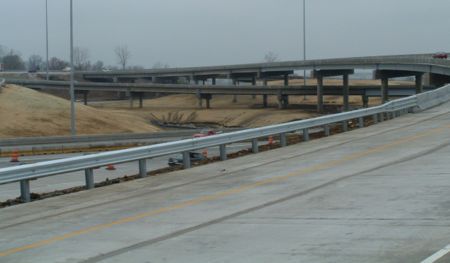Difference between revisions of "Category:606 Guardrail and Guard Cable"
m (article construction) |
m (article construction) |
||
| Line 19: | Line 19: | ||
Except for when it is used in medians, guard cable (instead of guardrail) on new construction projects is to be limited to locations outside the clear zone, but where the designer wants to protect an errant vehicle from driving over a steep, high fill area. Substitution of guard cable for guardrail is not recommended on sharp curves or on facilities with high truck traffic. Guard cable is also commonly used in freeway medians that are at least 36 ft. wide. | Except for when it is used in medians, guard cable (instead of guardrail) on new construction projects is to be limited to locations outside the clear zone, but where the designer wants to protect an errant vehicle from driving over a steep, high fill area. Substitution of guard cable for guardrail is not recommended on sharp curves or on facilities with high truck traffic. Guard cable is also commonly used in freeway medians that are at least 36 ft. wide. | ||
| − | ==='''Construction Inspection Guidelines'''=== | + | ==='''Construction Inspection Guidelines for [http://www.modot.mo.gov/business/standards_and_specs/Sec0606.pdf Sec 606]'''=== |
| − | + | ||
| − | + | '''606.3 Construction Requirements.''' Inspection of guardrail, crashworthy end terminals, three-strand guard cable and one-strand access restraint cable is usually done on a spot basis. The constractor is to be given enough reference points from which to establish line and grade. Points to check during installation are alignment of posts and possible damage from driving. Completed rail or cable should be checked for alignment, position with respect to the travelway, elevation and proper direction of lap for beams. Bolts are to be tight. All elements of construction are to be checked for damage. | |
| − | |||
Post driving frequently causes damage to stabilized shoulders. No installation is to be accepted until such damage has been satisfactorily repaired in a manner preventing ponding of water around the posts. | Post driving frequently causes damage to stabilized shoulders. No installation is to be accepted until such damage has been satisfactorily repaired in a manner preventing ponding of water around the posts. | ||
| − | |||
Revision as of 07:30, 23 March 2007
| Key Points |
About one in every three fatal accidents is a result of a single vehicle leaving the road. For this reason, roadside safety must be given the same level of scrutiny as the travelway. National best practice indicates the concept of the forgiving roadside as the responsible approach.
Shielding. In many cases, it is either impractical or impossible to remove the obstacle, redesign the obstacle so it can be safely traversed, relocate the obstacle to a point where it is less likely to be struck or reduce impact severity by using an appropriate breakaway device in order to produce a forgiving roadside. In these cases, shielding will likely be used to protect the errant vehicle from the obstacle. Shielding is simply the use of a barrier to physically separate the vehicle from the obstacle.
Barriers, whether they be concrete, guardrail or guard cable are themselves roadside obstacles. Even though they are engineered and rigorously tested to preserve the safety of vehicle occupants, all shielding systems cause damage to the vehicle and/or sustain damage themselves when struck. This is why their use is preferable only to obstacle delineation, which is widely considered a last resort.
Guardrail. Guardrail is used to protect traffic from roadside obstacles or to prohibit traffic movements. Guardrail is used when the severity of an accident involving an obstacle would be greater than the severity of an accident involving the protective guardrail. Standard design requires a 2 ft. (600 mm) distance of the obstacle from the guardrail. If the 2 ft. (600 mm) offset is not feasible, use of 7 ft. (2134 mm) guardrail posts (Type A guardrail only) at half-post spacing may be an option.
Guard Cable. Guard cable contains and redirects vehicles from impacting a fixed object or terrain that is less forgiving than the guard cable. It consists of steel cables mounted on weak posts and is relatively inexpensive to install and very effectively captures errant vehicles.
Except for when it is used in medians, guard cable (instead of guardrail) on new construction projects is to be limited to locations outside the clear zone, but where the designer wants to protect an errant vehicle from driving over a steep, high fill area. Substitution of guard cable for guardrail is not recommended on sharp curves or on facilities with high truck traffic. Guard cable is also commonly used in freeway medians that are at least 36 ft. wide.
Construction Inspection Guidelines for Sec 606
606.3 Construction Requirements. Inspection of guardrail, crashworthy end terminals, three-strand guard cable and one-strand access restraint cable is usually done on a spot basis. The constractor is to be given enough reference points from which to establish line and grade. Points to check during installation are alignment of posts and possible damage from driving. Completed rail or cable should be checked for alignment, position with respect to the travelway, elevation and proper direction of lap for beams. Bolts are to be tight. All elements of construction are to be checked for damage.
Post driving frequently causes damage to stabilized shoulders. No installation is to be accepted until such damage has been satisfactorily repaired in a manner preventing ponding of water around the posts.
Articles in "606 Guardrail and Guard Cable"
The following 3 pages are in this category, out of 3 total.
